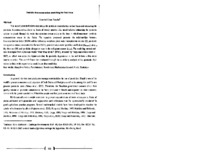Pesticide bioconcentration modelling for fruit trees.
Pesticide bioconcentration modelling for fruit trees.
Author(s): PARAIBA, L. C.
Summary: The model presented allows simulating the pesticide concentration in fruit trees and estimating the pesticide bioconcentration factor in fruits of woody species. The model allows estimating the pesticide uptake by plants through the water transpiration stream and also the time in which maximum pesticide concentration occur in the fruits. The equation proposed presents the relationships between bioconcentration factor (BCF) and the following variables: plant water transpiration volume (Q), pesticide transpiration stream concentration factor (TSCF), pesticide stem-water partition coefficient (KWood,w), stem dry biomass (M) and pesticide dissipation rate in the soil-plant system (kEGS). The modeling started and was developed from a previous model ?Fruit Tree Model? (FTM), reported by Trapp and collaborators in 2003, to which was added the hypothesis that the pesticide degradation in the soil follows a first order kinetic equation. The model fitness was evaluated through the sensitivity analysis of the pesticide BCF values in fruits with respect to the model entry data variability.
Publication year: 2009
Types of publication: Paper in annals and proceedings
Unit: Embrapa Environment
Keywords: Agrotóxico, Modelo Matemático
Observation
Some of Embrapa's publications are published as ePub files. To read them, use or download one of the following free software options to your computer or mobile device. Android: Google Play Books; IOS: iBooks; Windows and Linux: Calibre.
Access other publications
Access the Agricultural Research Database (BDPA) to consult Embrapa's full library collection and records.
Visit Embrapa Bookstore to purchase books and other publications sold by Embrapa.

